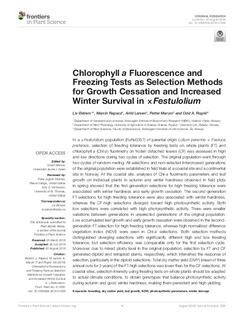| dc.contributor.author | Østrem, Liv | |
| dc.contributor.author | Rapacz, Marcin | |
| dc.contributor.author | Larsen, Arild | |
| dc.contributor.author | Marum, Petter | |
| dc.contributor.author | Rognli, Odd Arne | |
| dc.date.accessioned | 2018-11-13T11:42:53Z | |
| dc.date.available | 2018-11-13T11:42:53Z | |
| dc.date.created | 2018-10-01T14:33:12Z | |
| dc.date.issued | 2018 | |
| dc.identifier.citation | Frontiers in Plant Science. 2018, 9 . | nb_NO |
| dc.identifier.issn | 1664-462X | |
| dc.identifier.uri | http://hdl.handle.net/11250/2572208 | |
| dc.description.abstract | In a ×Festulolium population (FuRs0357) of parental origin Lolium perenne × Festuca pratensis, selection of freezing tolerance by freezing tests on whole plants (FT) and chlorophyll a (Chl-a) fluorimetry on frozen detached leaves (CF) was assessed in high and low directions during two cycles of selection. The original population went through two cycles of random mating. All selections and non-selected intercrossed generations of the original population were established in field trials at a coastal site and a continental site in Norway. At the coastal site, analyses of Chl-a fluorimetry parameters and leaf growth on individual plants in autumn and winter hardiness observed in field plots in spring showed that the first-generation selections for high freezing tolerance were associated with winter hardiness and early growth cessation. The second-generation FT-selections for high freezing tolerance were also associated with winter hardiness, whereas the CF-high selections diverged toward high photosynthetic activity. Both low selections were correlated with high photosynthetic activity. There were smaller variations between generations in unselected generations of the original population. Low accumulated leaf growth and early growth cessation were observed in the secondgeneration FT-selection for high freezing tolerance, whereas high normalized difference vegetation index (NDVI) were seen in Chl-a selections. Both selection methods distinguished diverging selections with significantly different high and low freezing tolerance, but selection efficiency was comparable only for the first selection cycle. Moreover, due to mixed ploidy level in the original population, selection by FT and CF generated diploid and tetraploid plants, respectively, which intensified the response of selection, particularly in the diploid selections. Total dry matter yield (DMY) (mean of three annual cuts for 3 years) of the FT-high selections was lower than for the CF-selections. At coastal sites, selection intensity using freezing tests on whole plants should be adapted to actual climate conditions, to obtain genotypes that balance photosynthetic activity during autumn and good winter hardiness, making them persistent and high yielding. | |
| dc.language.iso | eng | nb_NO |
| dc.rights | Attribution-NonCommercial-NoDerivatives 4.0 Internasjonal | * |
| dc.rights.uri | http://creativecommons.org/licenses/by-nc-nd/4.0/deed.no | * |
| dc.title | Chlorophyll a Fluorescence and Freezing Tests as Selection Methods for Growth Cessation and Increased Winter Survival in ×Festulolium | nb_NO |
| dc.type | Journal article | nb_NO |
| dc.type | Peer reviewed | nb_NO |
| dc.description.version | publishedVersion | |
| dc.source.pagenumber | 13 | nb_NO |
| dc.source.volume | 9 | nb_NO |
| dc.source.journal | Frontiers in Plant Science | nb_NO |
| dc.identifier.doi | 10.3389/fpls.2018.01200 | |
| dc.identifier.cristin | 1616823 | |
| dc.relation.project | Norges forskningsråd: 173319 | nb_NO |
| dc.relation.project | Norges forskningsråd: 199664 | nb_NO |
| cristin.unitcode | 192,10,2,0 | |
| cristin.unitname | Institutt for plantevitenskap | |
| cristin.ispublished | true | |
| cristin.fulltext | original | |
| cristin.qualitycode | 1 | |

